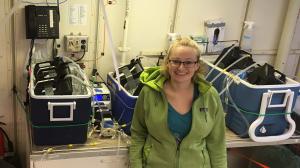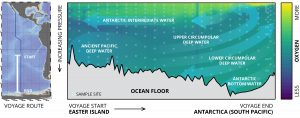New study reveals how deep ocean currents shape microbial life across the South Pacific
Until now, it was unclear whether these water masses also served as distinct microbial ecosystems. We can now answer that question with a resounding, yes.”
LA JOLLA, CA, UNITED STATES, July 10, 2025 /EINPresswire.com/ -- A groundbreaking study, published in the journal Science, has unveiled how deep ocean currents—known as global overturning circulation—play a pivotal role in shaping the diversity and function of microbial life across the South Pacific Ocean. This research, led by scientists from J. Craig Venter Institute (JCVI), Scripps Institution of Oceanography at the University of California San Diego, and University of California Berkeley offers the most detailed genetic map to date of how microbial communities are structured by the physical movement of ocean water.— Bethany Kolody, Ph.D., first author
The microbial conveyor belt
The ocean is not a uniform soup of water. In explaining this concept, Bethany Kolody, Ph.D., first author on the paper, noted that “winds and storms only reach to about 500 meters (1,640 feet),” about an eighth of the total ocean depth of 4000 meters (13,125 feet). Beyond 500 meters, currents are driven by differences in water temperature and salinity, which affects its density, forming the global overturning circulation. This circulation acts like a conveyor belt, transporting water—and the microbes within it—across vast distances and depths.
“Until now, it was unclear whether these water masses also served as distinct microbial ecosystems,” said Dr. Kolody. “We can now answer that question with a resounding, ‘yes.’”
Mapping microbial life from surface to seafloor
The research team collected over 300 water samples along a transect from Easter Island to Antarctica in the South Pacific, spanning the full depth of the ocean. Using advanced techniques, they reconstructed the genomes for more than 300 microbes and identified tens of thousands of additional microbial species using a molecular fingerprinting technique that looks at highly conserved genes—the 16S rRNA gene for prokaryotes (which includes both bacteria and archaea) and the 18S rRNA gene for eukaryotes.
Their findings revealed a striking pattern: microbial diversity increases sharply just below the ocean surface in a zone they call the “prokaryotic phylocline.” This layer, akin to the pycnocline (a zone of rapid density change), marks a transition from low-diversity surface waters to the rich microbial communities of the deep ocean.
Water masses as microbial provinces
The study identified six distinct microbial “cohorts,” three of which correspond to depths and the other three aligning with major water masses: Antarctic Bottom Water, Upper Circumpolar Deep Water, and ancient Pacific Deep Water. Each cohort harbors unique microbial species and functional genes, shaped by the temperature, pressure, nutrient levels, and age of the water.
The voyage to collect water samples began at Easter Island and ended near Antarctica in the South Pacific. Samples were taken at numerous depths to give a complete picture of microbial life at each location and have shed new understanding about how these populations are layered, each employing survival strategies for their specific environments. Image courtesy Bethany Kolody.
For example, the Antarctic Bottom Water cohort includes microbes adapted to cold, high-pressure environments, with genes that help maintain membrane fluidity and resist oxidative stress. In contrast, the ancient water cohort—found in slow circulating water that has not seen the surface in 1,000 or more years—hosts microbes with genes enabling life in low oxygen environments and the breakdown of complex, low-energy carbon compounds.
Functional zoning of the ocean
Beyond taxonomy, the researchers also mapped the functional potential of microbial communities. They identified ten “functional zones” based on the presence of key metabolic genes. These zones correspond to oceanographic features such as upwelling regions, nutrient gradients, and oxygen minimum zones.
Surface zones were rich in genes for light harvesting, iron acquisition, and photoprotection—traits essential for life in the sunlit upper ocean. Deeper zones featured genes for breaking down complex organic molecules, surviving low oxygen, and enduring environmental stress.
Implications for climate and carbon cycling
Microbes are the engines of the ocean’s carbon cycle. They convert carbon dioxide into organic compounds (carbon fixing), recycle nutrients, and help trap carbon in the deep sea (carbon sequestration). Understanding how their communities are structured by ocean circulation is crucial for predicting how climate change might alter these processes.
“The study provides a baseline for how microbial ecosystems are organized under current ocean conditions,” said Andrew Allen, Ph.D., senior author of the study and a microbial oceanographer at JCVI and Scripps Oceanography. “As climate change impacts global overturning circulation, the distribution and function of these microbial communities could shift, with unknown consequences for global carbon cycling.”
By pairing genomic data with physical and chemical measurements, scientists can build a global, species-resolved atlas of ocean life—essential for understanding and protecting the planet’s largest ecosystem.
Dr. Allen continued, “This study is a reminder that life in ocean ecosystems is, in part, governed by fundamental patterns and processes that are unknown to us. Seeing and understanding them requires that we examine them more sensitively, carefully, and thoroughly. The breakthroughs reported in this study are the result of a truly interdisciplinary effort involving physical oceanographers, biological oceanographers, and genome biologists all working very closely together. Agencies, such as the National Science Foundation, that support basic interdisciplinary ecological research in life and earth sciences, continue to be essential to our ability to understand factors that control the distribution, diversity, metabolism, and evolution of organisms in nature.”
-
The complete study, “Overturning circulation structures the microbial functional seascape of the South Pacific,” is published in the journal Science. This research was supported by the National Science Foundation, the Simons Foundation, the National Institutes of Health, the Emerson Collective, the Gordon and Betty Moore Foundation, and the Chan Zuckerberg Initiative.
About J. Craig Venter Institute
The J. Craig Venter Institute (JCVI) is a not-for-profit research institute in Rockville, Maryland and La Jolla, California dedicated to the advancement of the science of genomics; the understanding of its implications for society; and communication of those results to the scientific community, the public, and policymakers. Founded by J. Craig Venter, Ph.D., JCVI is home to approximately 120 scientists and staff with expertise in human and evolutionary biology, genetics, bioinformatics/informatics, information technology, high-throughput DNA sequencing, genomic and environmental policy research, and public education in science and science policy. JCVI is a 501(c)(3) organization. For additional information, please visit www.jcvi.org.
Matthew LaPointe
J. Craig Venter Institute
+1 301-795-7918
email us here
Visit us on social media:
LinkedIn
Bluesky
Instagram
Facebook
YouTube
X
Other
Legal Disclaimer:
EIN Presswire provides this news content "as is" without warranty of any kind. We do not accept any responsibility or liability for the accuracy, content, images, videos, licenses, completeness, legality, or reliability of the information contained in this article. If you have any complaints or copyright issues related to this article, kindly contact the author above.


